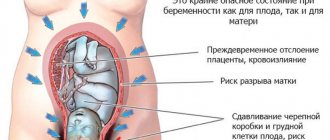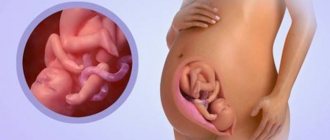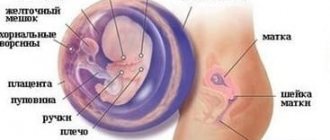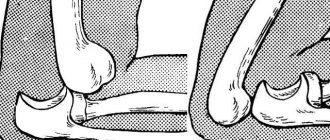Fetus at 39 weeks of gestation: movements
And, since the baby is already very large and already occupies almost the entire uterine cavity, he has nowhere to move much. Accordingly, if before this you could observe periodic “dancing” of the baby in your tummy, now he will only push you from the inside from time to time.
Although he has nowhere to move, the baby, nevertheless, tries to move. Moreover, through movements, the child trains coordination and gradually builds muscle strength. The intensity and nature of the movements should continue to be monitored: the mask should respond about 10-12 times per day. If the child shows excessive activity, pushes strongly and often, or, on the contrary, his movements are felt weakly and rarely, immediately inform the doctor about this: a change in the nature and frequency of movements in one direction or another indicates trouble.
Baby at 39 weeks of pregnancy The heart, lungs, intestines, kidneys - everything is ready to support the life of the baby outside the womb. However, the processes of development and improvement do not stop and will continue after birth. In particular, the central nervous system develops unevenly.
The pancreas begins to produce enzymes that will break down food entering the baby's stomach. But beneficial bacteria will begin to populate the intestines only after tasting colostrum - now it is sterile.
In most cases, immediately after birth, the newborn's intestines are emptied with meconium. But it often happens that this happens in the womb before the birth process begins (most often the cause is a lack of oxygen in the last stages of pregnancy). In such cases, doctors and obstetricians who deliver babies perform a special procedure to cleanse the bronchi, called lavage. As before, all nutrients reach the baby through the placenta. But in recent weeks it begins to age: its service life is coming to an end. The umbilical cord will be cut after childbirth only when it stops pulsating. And only then does the birth of the child’s place take place - the last third stage of labor.
Future mom
At the 39th week of pregnancy, the baby is already completely ready for independent existence, but ideally the pregnancy should still last this and next weeks. But you should have been completely ready for childbirth a few weeks ago. Although this does not mean at all that the expectant mother is obliged to lose peace and be in constant anticipation of the start of contractions.
If your bags for the maternity hospital are packed, and you are psychologically prepared for the events awaiting you, then you should not care. But it’s easy to say, but not easy to do, right? Some anxiety and nervousness are still present. The main thing is to listen to the baby, talk to him, reassure him before giving birth, but ask him not to linger - the time is approaching.
You will certainly understand that it has “started”: spasms will appear in the lower abdomen, repeating 5 times an hour, and then more often; you will feel nagging pain in the lumbar region; Your water may break and you may have some spotting. In the initial stages of labor, the mother may develop an appetite - prepare yourself some light, low-fat snack in advance.
future child
The baby is already a real hero. His height, on average, is 50-52 cm, and his weight is 3-3.5 kg, due to which there is not enough space for active actions and he is mainly in one position. But despite this, there is a possibility that the baby may wrap the umbilical cord around his neck or simply become entangled in it. These entanglements happen infrequently, so do not sound the alarm, but be sure to be sure that everything is fine with your tiny man.
The baby has sufficiently developed vision, sensitivity to contrast and volumetricity, determination of distance and depth, discrimination of colors, and also reactions to flickering and movement.
The child continues to grow. During this period, all organs and their systems have already been formed; the lungs, in turn, are waiting for their time to receive the first oxygen after birth. In the mother's womb, the baby feeds and breathes using the umbilical cord and placenta. It receives the necessary substances through a vein and two arteries intertwined into the umbilical cord.
The child’s activity slows down and he rarely moves. It's all about the cramped space that now shackles the future newborn.
All things needed for the maternity hospital must be collected. The baby's arrival is very close, so tune in to a positive note and gain physical strength.
Childbirth at 39 weeks of pregnancy: harbingers
In the meantime, until it “starts”, listen to yourself and track possible changes that will indicate the imminent onset of labor. Shortly before the start of labor, a woman learns about its approach by changes in appetite - it noticeably decreases. The weight of a pregnant woman can also decrease: many accomplished mothers say that the weight at the end of pregnancy, if it does not stop, then decreases by 1-2 kg.
False contractions, which until this time were painless and infrequent, now become more intense and palpable. In addition to the fact that contractions begin to appear more frequently, they occur against the background of a pulling in the abdomen and lower back: nagging pain ringing the lower abdomen and lumbar region is another of the harbingers of childbirth. You can distinguish false contractions from real ones - and many expectant mothers are very afraid of confusing them - by changing the position of the body. Do you feel like you're giving birth? Get up, walk around the apartment, sit down on the chair again. If the contractions have passed with a change in body position and type of activity, then it is too early to go to the maternity hospital.
The appearance of mucus in the vaginal discharge will indicate that labor is approaching - it can be either transparent or pinkish or brown. An admixture of mucus is particles of a mucous plug that closes the entrance to the uterus. Now the cervix is gradually softening and contracting, preparing for childbirth, so the particles of the plug come out. But you can see the mucus plug itself in the form of a lump of mucus, possibly streaked with blood, the volume of which is approximately 2 tablespoons. The release of the mucus plug is another signal that labor is about to begin.
Before giving birth, many women develop a nesting instinct: out of nowhere, strength and an irresistible desire to improve the house, making it as comfortable as possible, appear. Do not deny yourself this pleasure, but entrust the hard physical work to your assistants. Save your strength for the most important event in your life.
In the last days before giving birth, a woman may also notice disorders in the digestive system. Diarrhea, nausea, indigestion, perhaps even vomiting - all these symptoms may well precede the onset of labor. Well, while your tummy is calm, provide your baby with sufficient oxygen supply - go for a walk. But don’t go too far and be sure to take an exchange card with you.
More on the topic
Pain in the lower abdomen during pregnancy
How should your belly grow during pregnancy?
How long does discharge last after childbirth?
What kind of discharge should there be after childbirth?
37 weeks pregnant
Nutrition
At 39 weeks of pregnancy, the uterus is already located below and does not exert much pressure on the stomach; during this period, the mother experiences an increase in appetite. You need to control yourself, you should remember that before giving birth you cannot overload the body. It is advisable to slightly reduce the amount of food consumed to unload the intestines and remove excess water from the body.
The diet should include a sufficient amount of protein, which is found in cereals, fish and dairy products. But you need to reduce the amount of animal fats.
At this stage of pregnancy, it is recommended to increase the intake of carbohydrate foods. At this time, the mother will not gain extra pounds, but carbohydrates will maintain the required level of energy in case labor begins. Now it is allowed to eat white rice, biscuits, cottage cheese desserts, semolina, cookies, and sweet yoghurts. When choosing sweets, you should prefer natural products.
Complex carbohydrates, such as fiber, which contribute to normal bowel function, should be consumed in sufficient quantities. Therefore, pasta, raw vegetables, bread, and fruits are useful for a woman’s diet.
Belly at 39 weeks of pregnancy: tugs, hurts, droops
A drooping abdomen is another sign by which you will know that labor is imminent. In theory, the belly drops between 36 and 38 weeks of pregnancy, but this can happen now. Or it may not happen at all - some women do not notice a drooping belly until the onset of labor. If your stomach drops, you will definitely feel relief: it becomes easier to breathe, and the annoying heartburn will subside. Instead, there is a need for more frequent urination: the uterus puts pressure on the bladder, which means the need for more frequent emptying increases.
Do not worry if you suddenly find pain in the lower abdomen, extending to the lower back. Nagging pain localized in the “lower abdomen-lower back” at the 39th week of pregnancy is one of the normal variants, indicating the approach of labor.
In what cases should you urgently consult a doctor?
There are situations when it is necessary to urgently seek medical help.
This is best done for those whose stomach becomes stiff at 40 weeks of pregnancy, and the following symptoms are identified::
- bleeding;
- breaking of water;
- sudden hyperthermia;
- dizziness followed by loss of consciousness;
- no signs of the baby moving;
- regular contractions with a break of 5-10 minutes.
Why does the stomach become stone at 40 weeks of pregnancy? This sign indicates that everything is ready for the birth of the child, and all that remains is to wait for this meeting. During contractions, try not to be nervous, think that soon you will see your baby for the first time.
Pain at 39 weeks of pregnancy
So, we already know about the nature of pain in the lower abdomen and lower back - these are the consequences of preparing the body for the upcoming birth and its attempt to tell the woman about their inevitable approach.
Again, due to the body’s preparation for an imminent birth, you now probably feel pain in the pelvic region, in the sacrum, in the pubis. The body actively produces the hormone relaxin, the main task of which is to soften and relax ligaments and bones. Plus, the softened pelvic bones at this stage gradually diverge, preparing the baby the most favorable conditions for traveling through the birth canal. So the mother has to endure the pain caused by such changes in the body and wait for childbirth, after which the pain will go away on its own.
Surely you are already familiar with pain in the sacrum, in the back, in the spine. This is the result of a mixing of the center of gravity and increased loads. Leg pain is common for the same reason. In addition: due to compression of the femoral nerve, you may feel a shooting, aching pain in the back of the leg, sometimes reaching the knee. Recommendations for minimizing pain in the back, legs, and sacrum are still the same: regular unloading, sleeping in the correct position, proper rest, wearing a prenatal bandage.
By the way, by this time you may feel that your chest hurts. Don’t be surprised or scared: your breasts are now noticeably larger and heavier, and very soon they will be needed to feed your baby. Well, for now you patiently remove colostrum from your nipples and endure the usual pain and heaviness in your chest.
Discharge at 39 weeks of pregnancy
An important point this week is vaginal discharge: normally it should have a light milky color, uniform consistency and a slight smell of kefir. Don't be surprised to notice a slight increase in vaginal discharge - this is a normal symptom of the 39th week of pregnancy. Also, you should not be alarmed by the presence of mucus impurities in the discharge: transparent, perhaps with a shade of pink, brown, beige, the mucus is particles of the mucus plug that still covers the cervix today.
But here - mucopurulent discharge, curdled or flaky, green or yellow discharge should be a mandatory reason to consult a doctor. A change in discharge in this direction clearly indicates the development of any genital infection, and while there is still little time left, it is imperative to undergo treatment. After all, if this is not done and the infection remains with the mother, the woman will probably “share” this very infection when the baby travels through the birth canal.
Do not delay your visit to the maternity hospital if you notice even small amounts of amniotic fluid. You will recognize amniotic fluid by detecting a thin, watery discharge, perhaps of a slightly yellowish tint. The rupture of amniotic fluid is a sure sign that labor will begin in the very near future. At the same time, the water cannot always be poured out immediately, in one stream: it is possible for the amniotic fluid to drain in small portions. This happens when the integrity of the membranes is worn out or damaged, and poses a certain danger to the child - if the integrity of the membranes is damaged, he becomes vulnerable to infections. This is why the appearance of amniotic fluid cannot be ignored in any case.
Without delay, contact the ambulance operator even if you notice bloody discharge. Blood from the genital tract is a sign of abruption of a normally located placenta, a serious pathology that threatens the life and health of the baby. True, vaginal bleeding may also indicate placenta previa, but doctors have probably already ruled out this condition through preliminary multiple examinations.
Ultrasound
An ultrasound at 39 weeks of pregnancy is usually not required, however, there may be individual indications for repeat ultrasound examination. As before, during an ultrasound, the doctor examines the baby, its size, and determines the degree of development.
Again, the condition of the uterus, its size, and the degree of maturity of the cervix will be assessed. An important criterion is also the assessment of the quality and quantity of amniotic fluid. The degree of maturity of the placenta will be determined: at the 39th week of pregnancy, the placenta is often in the third degree of maturity. The higher the degree of maturity of the placenta, the greater the degree of wear and tear. But for now, the placenta continues to serve well - through it, antibodies are supplied to the baby from the mother, which take part in the formation of the immune system.
An ultrasound at 39 weeks of pregnancy will also give an idea of the location of the umbilical cord and eliminate the risk of the fetus being entangled in the umbilical cord. Keep in mind that entanglement with the umbilical cord is not a clear contraindication for natural childbirth: the umbilical cord is 55-65 cm long, which allows a woman to give birth on her own, and the umbilical cord itself is removed from the baby’s head immediately after birth. But, even if the umbilical cord is short and the noose around the neck is tightened as the baby passes through the birth canal, doctors, when monitoring and monitoring the birth process, react quickly and can decide to deliver by caesarean section.
Especially for beremennost.net – Elena Kichak
Feel
At the 39th week of pregnancy, the expectant mother experiences a lot of different feelings - from fear of the upcoming birth and accumulated physical fatigue to euphoria from the upcoming meeting with the long-awaited baby.
Towards the end of the gestational period, bearing a child becomes increasingly difficult. The significantly increased total weight and size of the fetus make themselves felt. Some of the baby's movements may cause pain to the mother. By the 39th week, all a woman’s thoughts are focused on one thing - a speedy birth.
Training contractions are already familiar to the pregnant woman and do not cause panic. It is worth remembering, however, that at this stage, cramping pain may be evidence of the beginning of labor. The difference is their greater pain and the appearance of periodicity.
Discharge
Throughout pregnancy, normal discharge from the genital tract is whitish in color and has a homogeneous consistency. The smell is either absent or has a sourish tint. The amount of discharge is scanty or moderate.
A normal occurrence for the 39th week of pregnancy is the release of the mucus plug that previously covered the cervical canal. This can happen several days before birth. A plug is a clot of mucus with streaks of blood embedded in it. Its separation is painless and can occur either simultaneously or in several stages.
At 39 weeks of pregnancy, monitoring the nature of the discharge is very important. A change in color to yellow or green, or the appearance of a foul odor may indicate a bacterial infection. In such cases, the doctor will decide on the possibility of treating the disease and the most appropriate method of delivery. In some cases, preference may be given to the surgical method. The reason for this is the possibility of infection of the fetus as it passes through the mother’s birth canal.
The appearance of bloody discharge from the genital tract is an ominous sign that may indicate the beginning of abruption of a normally located placenta. In this situation, you should immediately contact the obstetric hospital, as the child’s life is at risk.
Tone and the possibility of taking No-Shpa
Often pregnant women complain about the emerging tone of the uterus. They feel as if their stomach is turning to stone. This phenomenon is called training contractions. They are less painful than true ones, and there is no frequency of their occurrence. If they cause significant discomfort to the woman, the doctor monitoring the pregnancy may recommend taking No-shpa. This will help differentiate true contractions from false ones: when labor begins while taking the drug, contractions will continue to occur.
In recent years, in obstetric practice, it has been customary to prescribe No-shpa to prepare for childbirth in the last weeks of pregnancy. Taking it will facilitate the opening and softening of the cervix, ensure relaxation of its smooth muscles, which will help avoid ruptures during childbirth. For the fetus, taking the drug does not pose any danger.
Edema
The size of the uterus at the end of gestation is large. For this reason, blood flow in the body of the expectant mother is significantly hampered. The consequence of this is the appearance of edema. Their most likely localization is the lower limbs and hands. Normally, swelling is mild, appears in the morning or after a long walk and does not cause significant discomfort.
Limiting fluid intake and excluding salty and spicy foods from the diet will help combat it. The use of medications is allowed only after consultation with a doctor.
In a situation where swelling is severe and accompanies the pregnant woman throughout the day, you must immediately inform your doctor about it. Perhaps the appearance of edema is one of the symptoms of late gestosis - a serious complication of pregnancy that requires immediate medical attention.
Thrush
Vaginal candidiasis often occurs in women in late pregnancy. The reason for this is a decrease in the body's immune defense. To eliminate the risk of possible infection of the fetus during childbirth, it is necessary to treat thrush. The choice of drug is made by the doctor, taking into account all the characteristics of the expectant mother’s body. In some cases, antifungal therapy may be prescribed for prevention.
Headache and insomnia
The appearance of a headache at 39 weeks of pregnancy can be due to many reasons:
- late gestosis;
- arterial hypertension;
- decreased blood pressure;
- severe tension in the muscles of the shoulder girdle;
- strong emotional stress;
- infectious diseases of the upper respiratory tract.
If the pain occurs regularly or is severe, the woman should inform her doctor about it. He will help you find out the cause and select the optimal treatment.
In cases where headaches occur rarely, you can fight them with the help of certain recommendations.
- Hiking in the fresh air should become an integral part of every day for the expectant mother.
- Maintaining a sleep and rest schedule.
- Avoiding stressful situations.
- If pain occurs, applying a cool compress to the back of the head or massaging the temporal areas will help get rid of it or reduce its severity.
- If your blood pressure is low, you can get rid of headaches with a cup of natural coffee.
In case of increased blood pressure and headache, you should immediately consult a doctor.
Insomnia is the scourge of most pregnant women. It can bother a woman throughout pregnancy, reaching its peak at 39 weeks. The causes of this condition are:
- hormonal changes;
- emotional lability;
- physical discomfort.
All of them are especially pronounced in the last weeks of pregnancy. A woman experiences anxiety before the upcoming birth, she is worried about heartburn, frequent urination, and back pain. The belly, which has acquired an impressive size, makes it difficult to choose a comfortable position for sleeping. Training contractions, which often occur at night, also interfere with healthy sleep.
Daily walks, avoiding daytime naps, eating no more than three hours before bedtime, and a warm bath immediately before resting at night can help make it easier to fall asleep and improve the quality of sleep.











